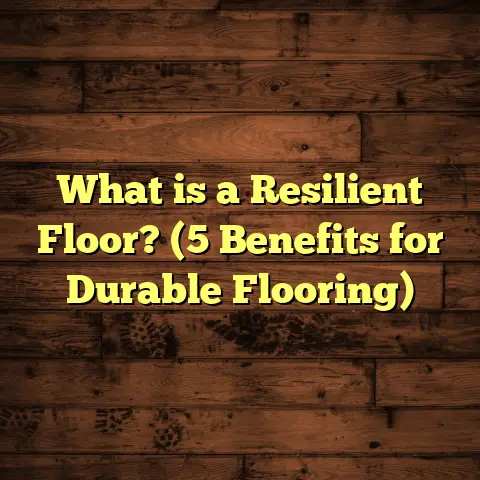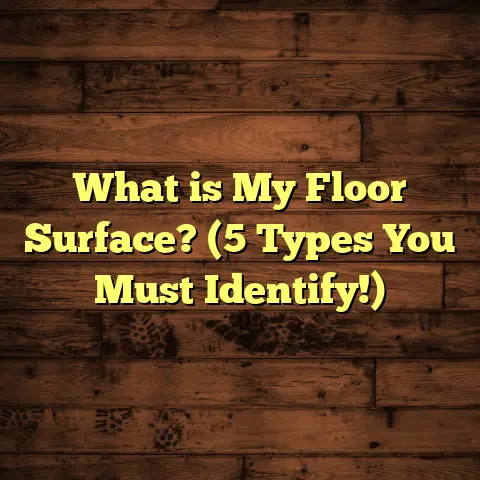What is Timber Flooring? (5 Benefits You Need to Know!)
I remember the first time I installed timber flooring in a client’s home. The entire space felt instantly warmer and more inviting, like it had been given a fresh new personality. That’s the magic of timber floors—they can completely change the way a home looks and feels. If you’ve ever wondered what timber flooring is all about and why so many people swear by it, let me walk you through everything I’ve learned over the years.
What Is Timber Flooring?
Timber flooring is simply flooring made from wood—real wood. Unlike synthetic materials or composites, timber floors come from natural trees, crafted into planks or strips that are then installed in your home. There are different types of timber flooring, including solid hardwood, engineered wood, and reclaimed wood, each with its own characteristics and benefits.
When I first started working with timber, I thought it was just about picking a pretty wood and installing it. But it’s so much more than that. The type of tree, how the wood is cut, treated, and finished—all affect the look, durability, and feel of the floor.
For example, oak and maple are some of the most popular hardwoods because they’re dense and durable. Meanwhile, softer woods like pine give a more rustic vibe but can dent more easily. Engineered wood floors have a thin layer of real timber on top of plywood or high-density fiberboard. This makes them more stable in areas where moisture might be an issue.
How Timber Flooring Is Made
To better understand timber flooring, let me break down how it’s made. It all starts with selecting quality logs. These are then cut into boards through several methods:
- Plain sawn (flat sawn): This is the most common method where logs are cut tangentially to the growth rings. It produces boards with a distinct grain pattern that many find attractive. However, these boards can be prone to cupping or warping.
- Quarter sawn: Logs are cut radially toward the center. This method produces boards with straighter grain patterns that are more stable and resist warping better. It also highlights unique grain features like ray flecks in oak.
- Rift sawn: A variation of quarter sawing that produces very straight grain and minimal medullary rays, favored for modern looks.
After cutting, the boards are kiln-dried to reduce moisture content, which is crucial to prevent shrinking or expanding after installation. Proper drying can take weeks depending on the wood type and thickness.
Next comes milling to smooth surfaces and cut planks to specific dimensions. Hardwood flooring is often sanded and finished before installation or finished on-site after laying.
Engineered wood flooring involves layering wood veneers crosswise with adhesives underneath a hardwood top layer. This layered construction improves strength and moisture resistance compared to solid hardwood.
Types of Timber Flooring
Here’s a quick rundown of common timber flooring types I work with:
- Solid Hardwood: Made from a single piece of wood throughout thickness. Can be sanded multiple times to refinish. Great durability but sensitive to moisture changes.
- Engineered Wood: A thin hardwood veneer on top of plywood or HDF layers. More dimensionally stable and suitable for basements or kitchens.
- Reclaimed Timber: Salvaged from old buildings or barns. Offers unique character and eco-friendliness but can be pricier due to processing.
- Parquet: Small blocks or strips arranged in geometric patterns for decorative flooring.
- Bamboo (Technically grass but marketed as timber): Fast growing and sustainable with good hardness properties.
Now that we’ve covered what timber flooring is, let me share why I believe it’s such a fantastic choice.
Why Timber Floors Stand Out: 5 Benefits You Need to Know
1. Natural Beauty That Lasts
One thing people often say after installing timber floors is, “Wow, this just feels right.” Timber has a unique warmth and character that you don’t get with other flooring materials. Over time, the wood develops a patina—a kind of aging that adds to its charm.
I’ve worked on projects where clients were hesitant about natural wood because they worried about scratches or fading. But in most cases, these marks add personality rather than detracting from the floor’s appeal. With proper finishing and maintenance, your timber floor can look stunning for decades.
Did you know that according to the National Wood Flooring Association (NWFA), hardwood floors can last 100+ years if properly cared for? That’s a huge longevity advantage compared to carpet or vinyl.
From my own experience, one family home I worked on still had its original 1920s oak floor intact—and it looked better than some newer floors I’ve seen! This durability is why many homeowners see timber as an investment rather than just an expense.
Beyond durability, timber brings natural variations in grain and color that make every plank unique—something synthetic floors can’t match. Some woods even change color with exposure to light—cherry wood becomes richer over time, while some species lighten naturally.
How Different Finishes Affect Beauty
The finish you choose impacts not only protection but also how your floor looks day-to-day:
- Oil finishes penetrate the wood for a matte, natural look but require periodic reapplication.
- Polyurethane finishes create a hard protective surface that can be glossy or matte; they’re easier to maintain but can mask some natural texture.
- Wax finishes offer a traditional soft sheen but are less common today due to maintenance needs.
I usually encourage clients to pick finishes based on lifestyle—oil finishes suit low-traffic areas or those who want a rustic look; polyurethane works well for busy homes needing durability.
2. Improved Indoor Air Quality
You might not think of flooring affecting air quality, but it does—big time. I’ve seen homes where carpet was holding onto dust, allergens, and pet dander, causing sneezing and irritation. Timber floors don’t trap allergens like carpet does.
In fact, studies show that homes with hard flooring often have better indoor air quality compared to those with carpeted floors. If you or someone in your family suffers from allergies or asthma, timber flooring could make a noticeable difference.
A study published by the American Academy of Allergy Asthma & Immunology showed that homes with hardwood floors had significantly lower levels of dust mites and allergens compared to carpeted homes.
Plus, timber floors don’t emit harmful VOCs (volatile organic compounds) if you choose low-VOC finishes. This creates a healthier environment inside your home.
In one renovation I handled for a family with young children who had eczema and asthma issues, switching from wall-to-wall carpet to timber flooring led to a clear improvement in symptoms within months—something their doctor confirmed was likely due to reduced allergen buildup.
3. Versatility in Style and Design
One reason I love working with timber floors is how adaptable they are. Whether your style is modern minimalism or cozy farmhouse, there’s a timber option that fits beautifully.
You can choose from various wood species, plank sizes, colors, and finishes—matte, glossy, distressed, or smooth. For instance, wide plank timber floors give a spacious feel and are great for open-plan areas. Narrower strips work well in classic settings.
I worked with an interior designer recently who wanted a mid-century modern look with clean lines. We opted for narrow walnut planks with a satin finish that perfectly complemented their furniture choices.
And if you want something unique, reclaimed timber offers an eco-friendly choice with lots of character from years gone by. Reclaimed wood often has nail holes, knots, and color variations that tell a story—a real conversation starter when guests visit.
You can also mix timber species or finishes within one room for creative effects—such as using darker wood around the perimeter as a border or creating patterns like herringbone or chevron for visual interest.
How Timber Flooring Works With Interior Trends
Trends come and go but timber adapts easily:
- Rustic/Industrial: Rough-sawn boards with matte finishes pair well with exposed brick and metal accents.
- Scandinavian: Light-colored woods like ash or birch with whitewashed finishes brighten spaces.
- Classic Traditional: Rich mahogany or cherry woods with polished finishes elevate formal rooms.
- Contemporary: Wide plank floors in dark stains add drama to minimalist interiors.
Whatever your taste might be today or five years from now, timber floors tend to blend effortlessly with evolving decor styles.
4. Long-Term Cost Effectiveness
I get asked a lot about cost because timber flooring often has a higher upfront price than laminate or vinyl. But here’s the thing: when you factor in durability and lifespan, timber can be more cost-effective over time.
A typical hardwood installation costs between $6 to $12 per square foot including labor but this varies depending on wood type and location. In comparison, laminate may start cheaper but usually needs replacement every 10-15 years.
One tool I use to keep track of expenses and avoid surprises is FloorTally. It helps me calculate accurate installation costs by factoring in material prices and local labor rates. It also considers waste factors so I don’t overbuy or underestimate materials needed.
From my experience managing multiple projects, having reliable cost estimates upfront saves headaches later on and helps clients stick to their budgets without compromise.
Here’s an example: A client once debated between laminate at $3/sq ft installed versus oak hardwood at $9/sq ft installed. Considering laminate’s lifespan was roughly 12 years while hardwood could last 50+ years with refinishing options included, the client saw hardwood as better value long-term—especially since resale value would improve too.
Case Study: Return on Investment
According to Remodeling Magazine’s Cost vs Value Report (2024), installing hardwood flooring returns about 70% of its cost upon resale in many US markets—higher than most other remodeling projects like kitchen remodels or bathroom renovations.
A recent project I completed in a suburban neighborhood showed this firsthand: after installing white oak hardwood floors throughout the main living areas, appraisal values increased by roughly 8% compared to similar homes nearby without hardwood floors.
This makes timber flooring not just beautiful but financially smart if you plan on selling your home someday.
5. Easy Maintenance and Repair
It’s true that timber floors require some care—but it’s not as much work as people think. Sweeping or vacuuming regularly keeps dust off the surface. Occasional mopping with a damp cloth prevents buildup without damaging the wood.
If your floor gets scratched or worn over time, sanding and refinishing can bring it back to life. This is something you just can’t do with laminate or vinyl once they’re damaged.
In one project I did recently, a homeowner had an old solid oak floor that was scratched all over from years of pets running around. After sanding down and applying a fresh finish, the floor looked brand new again—saving them thousands compared to replacing it outright.
Tips for Maintaining Your Timber Floors
Here are some of my personal tips based on years working hands-on with timber:
- Use furniture pads under chair legs to prevent dents.
- Avoid excessive water when cleaning; use slightly damp mops only.
- Wipe up spills immediately to avoid staining.
- Place rugs in high traffic areas like entryways.
- Consider professional refinishing every 7-10 years depending on wear.
- Avoid harsh chemical cleaners; use products designed for wood floors.
Following these simple steps helps keep your floor looking great longer without costly repairs down the line.
My Timber Flooring Experiences: Lessons Learned
Over the years, I’ve installed timber floors in everything from small apartments to large family homes. Each job taught me something new about how to get the best results.
For instance, climate plays a big role in how timber behaves after installation. In humid areas, engineered wood often performs better since it handles moisture changes without warping like solid wood can.
Also, choosing the right finish is crucial. Some finishes offer better scratch resistance but may be harder to repair later on. It’s always worth discussing lifestyle factors—like kids or pets—with your installer before deciding.
Another tip I learned the hard way: always acclimatize timber planks in your home’s environment for several days before installation. This minimizes expansion or contraction after fitting and prevents gaps or buckling later.
Real-Life Challenge: Moisture Issues
I once worked on a lakeside cabin where solid hardwood was installed too soon after delivery without acclimatization. The planks absorbed humidity from the air overnight causing them to expand significantly after installation—which led to buckling in several rooms requiring costly repairs.
After that experience, I never skip recommending at least 72 hours of acclimation time indoors before installation—sometimes longer depending on local conditions.
Personal Story: Finding the Perfect Match
A couple once came to me wanting dark walnut floors for their urban loft but were worried about maintenance because they had two dogs. After discussing their lifestyle extensively, we chose an engineered walnut floor with a matte scratch-resistant finish combined with area rugs in high traffic zones.
Six months later they reported being thrilled—not only did their floors hold up well but they loved how cozy their space felt thanks to the warm tones of walnut combined with soft textiles around seating areas.
Timber Flooring Facts and Stats You Should Know
- Timber accounts for nearly 40% of all residential flooring in the US.
- The global wood flooring market size was valued at $16 billion in 2023 and is expected to grow steadily.
- Oak is the most used hardwood species for flooring worldwide.
- Engineered wood makes up about 30% of timber flooring sales due to its moisture resistance.
- According to surveys, 85% of homeowners would choose timber floors again for their next renovation.
- Timber floors can increase home resale value by up to 5-10%, depending on market trends.
- A well-maintained timber floor can reduce indoor allergens by up to 50% compared to carpeted spaces.
- Bamboo flooring sales have increased by almost 20% year-over-year due to sustainability trends.
- The average lifespan of solid hardwood flooring exceeds 50 years; engineered wood typically lasts 20-30 years.
These numbers show just how popular and practical timber flooring remains—and why many people keep coming back for it despite cheaper alternatives being available.
What Should You Think About Before Choosing Timber Flooring?
Here are some questions I usually ask clients when we talk about timber floors:
- How much foot traffic does your space get daily?
- Do you have pets or children who might cause wear?
- What’s your local climate like—humid or dry?
- Are you looking for a specific style or color?
- How much are you willing to invest upfront vs long-term?
- Would you prefer solid hardwood or engineered wood?
Answering these helps tailor recommendations to your unique needs so you end up loving your floor for years.
Location Matters
Consider where you want your timber floor installed:
- Kitchens benefit from engineered wood due to occasional moisture exposure.
- Basements often require engineered options because solid hardwood can warp.
- Living rooms and bedrooms are ideal for solid hardwood if humidity control is good.
Knowing this helped me avoid costly mistakes on several jobs where clients initially wanted solid wood downstairs but switched after we discussed potential moisture risks.
Budgeting Smartly
Budget is always top of mind when picking floors. Here’s where tools like FloorTally come into play—they offer detailed cost breakdowns including materials, labor rates near you, waste factors (usually 5%-10%), and even installation complexity adjustments based on room shape or subfloor condition.
This tool helped one client avoid ordering excess materials by precisely calculating square footage after measuring odd-shaped rooms—which saved them hundreds in waste costs alone!
Final Thoughts: Why Timber Flooring Could Be Your Best Choice
I’ve seen firsthand how timber flooring transforms homes—from giving them timeless style to improving air quality and standing up against daily wear long-term. It’s not just about looks; it’s about creating spaces that feel good underfoot while being practical for everyday life.
If you’re thinking about changing your floors soon—or just curious about options—timber deserves serious thought. It offers beauty backed by science and experience plus benefits that other materials struggle to match without constant replacement or higher maintenance costs.
Have you ever stepped onto polished timber floors and felt that subtle comfort? That sensation often turns into lasting satisfaction once people realize how much life quality good flooring adds—not just visually but physically too.
If you want help estimating costs or planning installation logistics realistically based on your specific needs, tools like FloorTally combined with expert advice make life easier and less stressful from start to finish.
I hope this detailed look into timber flooring sheds light on why it continues winning hearts (and homes) everywhere I go—and maybe inspires you too!
If you have any questions about types of timber floors or need tips on care & maintenance from someone who’s been there personally—I’m here anytime for a chat!





